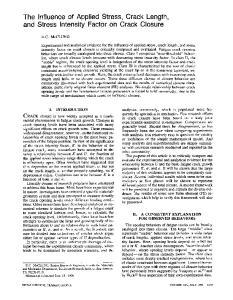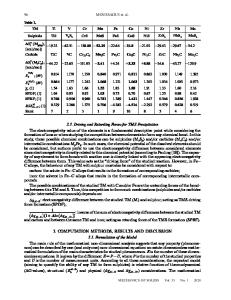On crack closure of precipitation hardened steels in aqueous solution
- PDF / 909,325 Bytes
- 5 Pages / 590.28 x 785 pts Page_size
- 66 Downloads / 335 Views
I.
INTRODUCTION
IN many
structural components, the failure by corrosion fatigue tends to increase with increasing strength when they are exposed in corrosive environments under cyclic loading. In order to improve the resistance to corrosion fatigue cracking, it is important to clarify what kinds of metallurgical factors control the resistance to fatigue cracking. Lately, it is shown m that fatigue crack propagation is largely influenced by crack closure. Crack closure E2jmeans that a fatigue crack is closed during the loading cycle, even above the minimum load, and especially at lower AK levels. Since crack closure can reduce fatigue crack growth rates, it is advantageous to determine the factors enhancing the crack closure behavior. The effects of grain size [3] or aging conditions ]41 on crack closure as well as fatigue crack growth behavior have received considerable attention. The effects of slip character and slip length on fatigue crack propagation rates and fracture path (crack branching or surface irregularity) have been investigated.J5.6] Increasing grain size and underaging structures (containing coherent precipitates with the matrix) have been shown to promote surface irregularity and faceted fractures at low fatigue crack propagation rates for iron-, ~3~ aluminum-, I41 and titanium-based ]51 alloys. The reason for these occurrences is thought to be that the structures show more planar and inhomogeneous slip character on deformation and promote roughness-induced crack closure at near-threshold fatigue crack growth rates. But in a corrosive environment, the relation between crack closure and microstructures of the components is unclear. In this study, the crack closure behavior, as well as the fatigue crack growth rates of age-hardenable high strength steels, was investigated in a 3.5 pct NaC1 aqueous solution. The aim of the present paper is to make clear
R. HAMANO, Senior Researcher, is with the National Research Institute for Metals, Tsukuba Laboratories, 1-2-1, Sengen, Tsukubaschi, Ibaragi-ken, 305, Japan. Manuscript submitted January 15, 1988. METALLURGICAL TRANSACTIONS A
the effects of aging conditions on crack closure response in a corrosive environment.
II.
EXPERIMENTAL PROCEDURES
The material used in the study was melted in a vacuum induction furnace. The chemical composition was as follows: C, 0.14 pct; Ni, 5.07 pct; A1, 1.94 pct; Mo, 1.55 pet; Cr, 1.73 pct; Mn, 0.19 pct; and S, 0.005 pct. After hot forming, the 10 m m thick plates were austenitized at 1100 ~ for 30 minutes, water quenched, and then aged at 510 ~ for 1 hour or at 650 ~ for 48 hours. After aging at 510 ~ for 1 hour, the specimens were hardened due to precipitation of NiA1 and M z C which were coherent with the matrix (underaged condition). Meanwhile, after aging at 650 ~ for 48 hours, the precipitates consisted of M z C and NiA1, both of which lost coherency with the matrix (overaged condition). [71 The room temperature mechanical properties were as follows: 0.2 pct offset strength of 1330 MPa and ultimate strength of 158
Data Loading...











